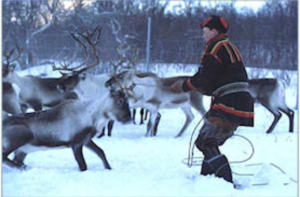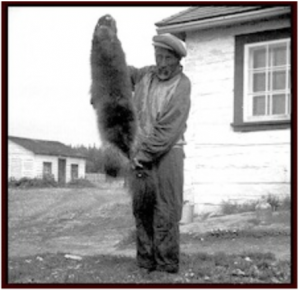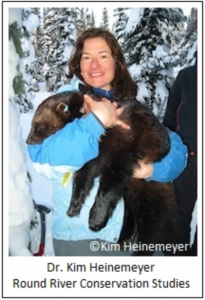The wolverine is relatively scarce across its circumpolar range, with regional status ranging from secure to endangered and, in some locales, possibly extirpated. Globally, the wolverine is classified as vulnerable (Mustelid Specialist Group 1996). There is also a diversity of conservation and management concerns in many areas where the wolverine occurs. These concerns include primarily habitat fragmentation, overexploitation, and depredation conflicts with sheep and reindeer husbandry (Landa et al. 2000, Slough 2007, Zhang et al. 2007). Recently, concern has also been raised about the potential negative impact of global warming on wolverine populations (Copeland et al. 2010). Some concerns about wolverine management/conservation are common to many areas of wolverine distribution, while some are more specific to particular regions. Therefore, we will present a brief overview of concerns for different regions below.
Scandinavia
 The Scandinavian wolverine population’s distribution and size declined markedly during the 1900s (Flagstad et al., 2004). The more recent recovery of the wolverine population has been accompanied by increasing depredation of free-ranging sheep grazing unattended on summer pastures in Norway and semi-domestic reindeer in Sweden and Norway, leading to conflicts and high compensation costs (Swenson and Andrén, 2005).
The Scandinavian wolverine population’s distribution and size declined markedly during the 1900s (Flagstad et al., 2004). The more recent recovery of the wolverine population has been accompanied by increasing depredation of free-ranging sheep grazing unattended on summer pastures in Norway and semi-domestic reindeer in Sweden and Norway, leading to conflicts and high compensation costs (Swenson and Andrén, 2005).
Currently, the wolverine population is listed as vulnerable in Sweden (Gärdenfors, 2010) and endangered in Finland and Norway (The Norwegian Biodiversity Centre). Current attempts to manage conflicts in Sweden are mainly based on a system of compensation for damage caused by wolverines, but also lethal harvest of wolverines and law enforcement against poaching (Persson et al. 2009). Compensation is based on the number of wolverines and other large carnivores within the reindeer grazing community. Lethal control of wolverines is only allowed in special cases as a final conflict-mitigating measure and is presumably of limited importance on a population level. In Norway, the compensation for wolverine depredation on sheep and semi-domestic reindeer is based on documented and assumed losses (Swenson and Andrén 2005). In contrast to Sweden, harvest (licensed hunting and lethal control) is used extensively as a tool to decrease depredation losses in Norway (Bröseth et al. 2010). As a result of the conflict with animal husbandry, poaching and legal harvest forms a substantial part of wolverine population dynamics in northern Scandinavia (Persson et al. 2009).
Furthermore, May et al. (2006), hypothesized that wolverine distribution may be partly influenced by direct disturbance or higher risk of human-caused mortality associated with infrastructure. Increased human development and activity in once-remote areas may thus cause reduced ability of wolverines to perform their daily activities unimpeded, making the habitat less optimal or causing wolverines to avoid the disturbed area. In addition, the dependence of wolverines on wild and semi-domestic reindeer in Scandinavia indicates that wolverines are vulnerable to indirect loss of habitat (May et al. 2006).
North America
 Slough (2007) reports that in Canada, wolverines are found in northern forested wilderness across the country, in alpine tundra of the western mountains, and in the arctic. They formerly occupied habitats that are now heavily settled by humans in the Prairie Provinces and eastern Canada. Forest harvesting, hydroelectric development, exploration and development of oil, gas and minerals, transportation corridors and human settlement continue to alter, remove, or fragment habitats. About 6% of all current wolverine range in Canada is within parks and protected areas, and 10% of high quality habitats in western Canada are protected. Wolverine populations are apparently benefiting from the cessation of wolf poisoning, harvest closures, and advanced trap line and harvest management systems. Recent range recoveries have been recorded in northwestern Ontario and Manitoba, where caribou numbers have increased. Wolverine populations in Canada are stable within the normal range of long-term population fluctuations elsewhere, except locally in southern Alberta and British Columbia where caribou have declined or habitats are becoming fragmented. The eastern wolverine population is either extremely rare or extirpated. The COSEWIC (Committee on the Status of Endangered Wildlife in Canada) status designations are endangered for the eastern population and Special Concern for the western population.
Slough (2007) reports that in Canada, wolverines are found in northern forested wilderness across the country, in alpine tundra of the western mountains, and in the arctic. They formerly occupied habitats that are now heavily settled by humans in the Prairie Provinces and eastern Canada. Forest harvesting, hydroelectric development, exploration and development of oil, gas and minerals, transportation corridors and human settlement continue to alter, remove, or fragment habitats. About 6% of all current wolverine range in Canada is within parks and protected areas, and 10% of high quality habitats in western Canada are protected. Wolverine populations are apparently benefiting from the cessation of wolf poisoning, harvest closures, and advanced trap line and harvest management systems. Recent range recoveries have been recorded in northwestern Ontario and Manitoba, where caribou numbers have increased. Wolverine populations in Canada are stable within the normal range of long-term population fluctuations elsewhere, except locally in southern Alberta and British Columbia where caribou have declined or habitats are becoming fragmented. The eastern wolverine population is either extremely rare or extirpated. The COSEWIC (Committee on the Status of Endangered Wildlife in Canada) status designations are endangered for the eastern population and Special Concern for the western population.
In Alaska, wolverines occupy nearly all areas of the state and are classified as furbearers and big game (Golden et al. 2007). In contrast, in the contiguous United States, dramatic contractions have occurred within the historical range of the wolverine since the 1800s. Although the species once occurred in California, Utah, Colorado, and the Great Lakes states, the wolverine’s current range is limited to north-central Washington, northern and central Idaho, western Montana, and northwestern Wyoming (see Aubry et al. 2007, Schwartz et al. 2007).
Low wolverine densities, fragmentation of suitable habitat, and high demographic sensitivity to adult mortality raise concerns that harvesting of wolverines at the southern extent of their North American range could have a detrimental effect on their metapopulation dynamics. The current understanding is that no other type of human activity has the same potential to cause populations to become dangerously small or locally extirpated (Ruggiero et al. 2007). Thus, decisions concerning wolverine harvest appear to be critical to the persistence of extant populations and to the recolonization of depleted populations, especially in isolated mountain ranges (Lofroth and Ott 2007, Squires et al. 2007). In the United States, wolverines may be harvested only in Alaska and Montana. Outside of these areas a lack of basic information on wolverine distribution and habitat requirements has resulted in little management beyond administrative protection.
Another concern regarding wolverine conservation in North America is fragmentation and disturbance of habitats due to resource extraction (including timber harvesting), backcountry skiing, snowmobiling and roads. For example, a study in British Columbia found a consistent negative association between wolverine occurrence and roads and areas where helicopter and backcountry skiing occur (Krebs et al. 2007). However, the causal factors associated with these patterns are not well understood (see Copeland et al. 2007, Krebs et al. 2007). In relation to this, it is suggested that protection of especially natal denning habitat from human disturbance may be critical for the persistence of wolverine (Magoun and Copeland 1998). The association between wolverine presence and refugia may be strongly linked to a lack of available natal denning habitat outside protected areas.
Asia
Novikov (2005) reports that the restructuring of the economy and social life in Russia in the late 20th century influenced the condition of different game populations. The breakdown of industrial links and unemployment forced many people to turn to poaching. All this affected primarily ungulate populations. Wild reindeer suffered serious changes to their numbers during the last decade. The decrease in wild reindeer numbers affected the condition of wolverine populations. The last decade was also very difficult for domestic reindeer breeding, with a loss of almost half of the animals. The domestic reindeer breeding losses had impact on wolverine population condition and numbers. Currently the majority of wolverines live in the Russian Far East, where preservation of the species is secured by a low human density, high density of wild reindeer, and favorable habitat conditions in the taiga. Some decrease in wolverine numbers in the European part of Russia and in western Siberia in the last decade of the 20th century can be explained, but the situation can hardly be mended soon.
Wolverine are known to occur in Mongolia along its northern border with Russia and extending south along the Altai Mountain Range in western Mongolia. The wolverine is unprotected in Mongolia and is occasionally killed for it fur although it is not considered a particularly valuable commodity. Current efforts are underway to better understand the wolverine’s status and conservation needs in Mongolia.
The wolverine distribution in China is decreasing and the population size may be <200 individuals. Is has been suggested that habitat loss, food limitation and poaching are the main reasons for the decline of the wolverine population in China (Zhang et al. 2007).
General
 It appears that the future influence of global warming, current effects of habitat fragmentation, harvest and poaching, as well as indirect influence by declining populations of ungulates and other large predators, are management issues shared by many wolverine populations in Eurasia and North America.
It appears that the future influence of global warming, current effects of habitat fragmentation, harvest and poaching, as well as indirect influence by declining populations of ungulates and other large predators, are management issues shared by many wolverine populations in Eurasia and North America.
Current research suggests that areas characterized by persistent spring snow cover, which in previous studies have been shown to strongly correlate with wolverine denning locations and year-round movement, also is correlated with gene flow (Schwartz et al. 2009, Copeland et al. 2010). Importantly, spring snow cover, and the bioclimatic niche that it indicates, is likely to continue to be strongly impacted by global climate change (Mote et al. 2005), threatening wolverine throughout their geographic distribution.
Habitat loss, fragmentation, and disturbance, can have direct influence on wolverine population persistence and is an issue in large parts of the wolverine distribution (Zhang et al. 2007, Novikov 2005, May et al. 2006, Ruggiero et al. 2007, Krebs et al. 2007).
A close relationship exists between wolverine populations and ungulate presence. Therefore, management practices that reduce carrion may affect wolverine foraging success, and hence reproduction (Persson, 2005). Ungulate carrion is a primary food item and activities that decrease large mammal populations may negatively affect carrion availability. Excessive hunter harvesting and loss of ungulate wintering areas (Banci 1994), as well as displacement of ungulate populations due to excessive timber harvest and urbanization, may adversely impact wolverines. Similarly, other large predators can be important providers of carrion for wolverines (van Dijk et al. 2008, Mattisson 2011), and thus the preservation of other predator populations can be of great importance for wolverine population persistence.
To avoid harvest that is not sustainable appropriate regulations are needed. For example, North American researchers suggest the importance of refugia of protected populations (Krebs et al. 2004, Squires et al. 2007). A somewhat special situation occurs in Scandinavia, where poaching is a significant part of wolverine population dynamics (Persson et al. 2009). Hence, conservation of wolverines needs to acknowledge strategies to limit poaching in their plans, even in protected populations. Large demographic stochasticity is an important characteristic of wolverine population dynamics, influencing population viability (Sæther et al. 2005). Also, population viability is generally strongly influenced by changes in population growth rate. Sæther et al. (2005) suggest that limiting poaching, and legal harvest of small populations, will increase population specific growth rate and reduce stochastic influences on population viability. The conservation of wolverines in Scandinavia represents a unique conservation challenge with an endangered species living in conflict with an indigenous reindeer–herding culture. In essence, the cultural norms within the indigenous reindeer–herding culture are in conflict with the cultural norm within the dominating society not allowing wolverines to be killed as a proactive depredation action. Instead, the dominating society favors conservation actions. The human dimension challenge for the conservation of the endangered wolverine population is to reveal the underlying social, psychological, and economic factors behind poaching among different groups (Persson et al. 2009).
The last ten years have brought about significant advances in our knowledge of wolverines, from basic ecology to increased understanding of impacts of human disturbance, to the development of increasingly sophisticated monitoring and research tools. To improve wolverine management and conservation, there is a need for collaboration on designing research projects, publishing results, and improving communication among researchers and managers across wolverine range.
Literature Cited
Aubry, K. B., K.S. McKelvey, and J.P. Copeland. 2007. Distribution and broad scale habitat relations of the wolverine in the contiguous United States. Journal of Wildlife Management 71:2147–2158.
Banci, V. 1994. Wolverine. In: Ruggiero, L.F., Aubry, K.K., Buskirk. S.W., Lyon, L.J. and Zielinski, W.J. (eds). The scientific basis for conserving forest carnivores. American marten, fisher, lynx and wolverine in the western United States. U.S. Forest Service General Technical Report RM-254. Fort Collins, Colorado, USA. pp. 99-123.
Broseth, H., Ö.Flagstad, C. Wärdig, M. Johansson,and H. Ellegren. 2010. Large-scale noninvasive genetic monitoring of wolverines using scats reveals density dependent adult survival. Biological Conservation 143(1):113-120.
Copeland, J., K. McKelvey, K. Aubry, A. Landa, J. Persson, R. Inman, J. Krebs, E.Lofroth, H. Golden, J. Squires, A. Magoun, M. Schwartz, J. Wilmot, C. Copeland, R. Yates, and R. May. 2010. Does spring snow cover define the bioclimatic envelope of the wolverine? Canadian Journal of Zoology 88: 233-246.
Copeland, J.P., J.M. Peek, C.R. Groves, W.E. Melquist, K.S. McKelvey, G.W. McDaniel, C.D. Long, and C.- E. Harris. 2007. Seasonal habitat associations of the wolverine in central Idaho. Journal of Wildlife Management 71:2201–2212.
Flagstad, Ø., E. Hedmark, A. Landa, H. Brøseth, J. Persson, R. Andersen, P. Segerström, and H. Ellegren. 2004. Colonization history and non-invasive monitoring of a re-established wolverine population. Conservation Biology 18:1–13.
Gärdenfors, U. 2010. How are species red listed? Manual and guidelines. Artdatabanken, SLU, Uppsala, Sweden.
Golden, H., A. Christ, and E. Soloman. 2007. Spatiotemporal analysis of wolverine Gulo gulo harvest in Alaska. Wildl Biol 13(Suppl 2):68–75.
Krebs, J., E. Lofroth, J. Copeland, V. Banci, D. Cooley, H. Golden, A. Magoun, R. Mulders and B. Shults. 2004. Synthesis of survival rates and causes of mortality in North American wolverines. Journal of Wildlife Management 68;493–502.
Krebs, J. E.C. Lofroth and I. Parfitt. 2007. Multiscale habitat use by wolverines in British Columbia, Canada. Journal of Wildlife Management 71:2180–2192.
Landa, A., M. Lindén and I. Kojola. 2000. Action Plan for the Conservation of Wolverines (Gulo gulo) in Europe. – The Council of Europe, Concile of Europe Publishing, Nature and Environment T-115, 45 pp.
Lofroth, E.C. and P.K. Ott. 2007. Assessment of the sustainability of wolverine harvest in British Columbia, Canada. Journal of Wildlife Management 71:2193–2200.
Magoun, A.J. and J.P. Copeland. 1998. Characteristics of wolverine reproductive den sites. Journal of Wildlife Management 62:1313–1320.
Mattisson, J. 2011. Interactions between Eurasian Lynx and Wolverines in the Reindeer Husbandry Area. PhD-thesis. Swedish University of Agricultural Sciences, Uppsala, Sweden.
May, R., A. Landa, J. van Dijk, and R. Andersen. 2006. Impact of infrastructure on habitat selection of wolverines. Wildl. Biol. 12, 285–295.
Mote, P.W., A.F. Hamlet, M.P. Clark, and D.P. Lettenmaier. 2005. Declining mountain snowpack in western North America. Bulletin of the American Meteorological Society 86:39–49.
Mustelid Specialist Group. 1996. Gulo gulo. In: IUCN 2006. 2006 IUCN red list of threatened species. www.iucnredlist.org.
Novikov, B. 2005. The contemporary condition of wolverine populations and numbers in Russia. In: Persson, J. and Wikenros, C. (eds.) 2005. First International Wolverine Symposium. Agenda and abstracts.
Persson, J. 2005. Female wolverine reproduction: reproductive costs and winter food availability. Canadian Journal of Zoology 83:1453–1459.
Persson, J., G. Ericsson and P. Segerström. 2009. Human caused mortality in an endangered wolverine population. Biological Conservation 142:325-331.
Ruggiero , L. K. McKelvey, K. Aubry, J. Copeland, D. Pletscher, and M. Hornocker. 2007. Wolverine Conservation and Management. Journal of Wildlife Management 71 (7):2145.
Saether, B.-E., S. Engen, J. Persson, H. Brøseth, A. Landa and T. Willebrand, .
2005. Management strategies for the Scandinavian wolverine: practical application of stochastic models in Population Viability Analysis. Journal of Wildlife Management 69: 1001-1014.
Schwartz, M.K., J.P. Copeland, N.J. Anderson, J.R. Squires, R.M. Inman, K.S. McKelvey, K.L. Pilgrim, L.P. Waits and S.A. Cushman. 2009. Wolverine gene flow across a narrow climatic niche. Ecology, 90(11):3222–3232.
Schwartz, M.K., K.B. Aubry, K.S. McKelvey, K.L. Pilgrim, J.P. Copeland, J.R. Squires, R.M. Inman, S.M. Wisely, and L.F. Ruggiero. 2007. Inferring geographic isolation of wolverines in California using historical DNA. Journal of Wildlife Management 71:2170–2179.
Slough, B. 2007. Status of the wolverine Gulo gulo in Canada. Wildlife Biol 13(Suppl 2):76–82.
Squires, J.S., J.P. Copeland, T.J. Ulizio, M.K. Schwartz, and L.F. Ruggiero. 2007. Sources and patterns of wolverine mortality in western Montana. Journal of Wildlife Management 71:2213–2220.
Swenson, J.E. and H. Andrén. 2005. A tale of two countries: large carnivore depredations and compensation schemes in Sweden and Norway. In: Woodroffe R, Thirgood S, Rabinowitz A (eds) People and wildlife: conflict or co-existence? Cambridge University Press, Cambridge, pp 323–339.
The Norwegian Biodiversity Centre (http://www.artsportalen.artsdatabanken.no/#/Rodliste2010/Vurderinger/Gulo+gulo/48072)(accessed 2010-12-06).
Van Dijk, J., L. Gustavsen, A. Mysterud, R. May, Ø. Flagstad, H. Brøseth, R. Andersen, R. Andersen, H. Steen and A. Landa. 2008. Diet shift of a facultative scavenger, the wolverine, following the recolonization of wolves. J. Anim. Ecol. 77;1183–1190.
Zhang M, Q. Liu, R. Piao and G. Jiang. 2007. The wolverine Gulo gulo population in the Great Kinghan Mountains, northeastern China. Wildlife Biol 13(Suppl 2):83–88.
 Follow
Follow